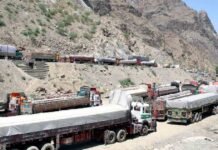In the dusty scrub of the Thar desert, Pakistan has begun to dig up one of the world’s largest deposits of low-grade, brown, dirty coal to fuel new power stations that could revolutionise the country’s economy.
The project is one of the most expensive among an array of ambitious energy developments that China is helping the country to build as part of a $55 billion economic partnership. A $3.5 billion joint venture between the neighbours will extract coal to generate 1.3 gigawatts of electricity that will be sent across the country on a new $3 billion transmission network.
“When I came, it was a mess. There was nothing here,” said Dileep Kumar, one of the first mining engineers at lead contractor Sindh Engro Coal Mining Co., standing atop the mile-wide hole in the earth, busy with yellow trucks and diggers on the floor below. “Now look at it. This wasn’t possible without the Chinese.”
On paper, Pakistan could be one of Asia’s top economies, with almost 200 million people spread over an area twice the size of California, from the ice-bound peaks of the Karakorum to the warm, dry shores of the Arabian Sea. But it remains hobbled by corruption, political turmoil, terrorism and poverty,
Solar Park
The country has natural gas reserves, four nuclear-power stations and the world’s largest dam. Some 700 kilometres north of the Thar mine another Chinese company is helping build a solar farm eight times the size of New York’s Central Park. Yet power outages remain a way of life with blackouts of 12 hours or more even in Karachi and Islamabad. By one estimate, the shortage of electricity is wiping 2 percentage points off the economic growth every year.
Thirst for energy is taking Pakistan in the opposite direction of Western countries that are trying to reduce coal power or use cleaner-burning fuel and technologies. Germany, which still relies on coal-fired stations for two-fifths of its electricity, has promised to switch half of them off by 2030.
Pakistan, by contrast, relies on coal for just 0.1 per cent of its power, according to the Pakistan Business Council. The Thar projects and others could see that jump up to 24 per cent by 2020, according to Tahir Abbas, an analyst at Karachi-based brokerage Arif Habib Ltd.
Pakistan’s coal reserves would give the nation a cheap domestic alternative to expensive oil and gas imports. The nation spends about $8 billion a year on imported petroleum and is one of the region’s biggest buyers of liquefied natural gas.
In an effort to curb the import bill and meet demand for power, Pakistan plans to dig up some of the world’s biggest known deposits of lignite, a lower-grade brown coal. But first, it must clear 160 metres of sand to get to the coal.
On a flat, arid plain, separated from a hot cerulean sky by a thin line of spindly scrub, yellow-edged containers sit neatly around paved quadrangles. In the centre of each, a lumpy circle of green turf, irrigated by a hosepipe, provides some respite from the dust and heat.
The Spartan accommodation houses about 350 Chinese workers on six-month stints, working 6 a.m. to 6 p.m. with a three-hour break during the hottest part of the day, when summer temperatures can reach up to 42 degrees Celsius (108 Fahrenheit).
Separate Quarters
Nearby, similar compounds house Pakistan’s engineers and workers, mostly from Karachi. The two groups keep separate schedules and take separate meals, with the cook turning meat into biryani and curries for one side, and dumplings for the other.
A kilometre from the living compounds, a massive square terraced hole is being carved out of the dust. Yellow Chinese dump trucks made by Shaanxi Tonly Heavy Industries Co. line up at the bottom to be filled with dirt by hydraulic excavators.
Many of the drivers of the fleet of 125 trucks are locals, Hindus and Muslims. In every cab and cabin are bottles of Nestle’s mineral water, a precious resource. For everything else, washing of ore, dumping of coal dust, bathing, the company extracts groundwater.
“Engro will reach the coal by the end of 2018, six months earlier than the scheduled time,” Chief Executive Officer Shamsuddin Ahmad Shaikh said in an interview. After decades of delays, the injection of Chinese capital and resources has made investors and companies believe the project will finally happen.
“All the big industrial groups in Pakistan have already asked us to give them coal for future power plants,” said Shaikh.
And this is only the start. Engro has already begun digging a second pit and another Chinese joint venture, Sino-Sindh Resource Pvt., and Shanghai Electric Group Co. plan to start on a similar coal power project in June. Oracle Coalfields Plc plans coal production and electricity at another block by 2019.
Desert Dividend
In all, the Thar region could produce enough coal to generate 15 gigawatts within 10 years, Mohammad Younus Dagha, secretary of Pakistan’s Ministry of Water and Power, said in a phone interview. That’s the equivalent of all the domestic and industrial solar power installed throughout the U.S. last year.
“Coal is about economies of scale,” said Dagha, who estimates the cost will fall until coal is Pakistan’s cheapest option in the energy chain.
For the Chinese, the projects in Thar have the potential for healthy profits and contracts for its companies and workers at a time when China itself is trying to reduce dependence on coal. It also bolsters China’s partnership with a country that offers a strategic trade link to the Arabian Sea and the Middle East, bypassing India.
Return on equity at the Engro mine is around 30 per cent, Abbas said. “That is very lucrative.”
Courtesy of Bloomberg






















